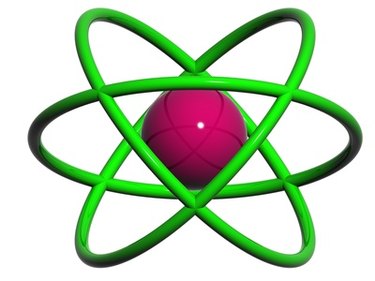Things You'll Need
Craft foam balls
Craft or tempera paint
Paint brush
Newspaper
Toothpicks
Clear-drying, non-toxic glue
Thin gauge wire
Wire cutter/clipper
Fishing line
Scissors

Atoms are the building blocks of elements. Without the atom we wouldn't have water, oxygen or any of the other necessities for life on Earth. Although the atom is so small that it cannot be seen with the naked eye, atoms are actually made up of even smaller subatomic particles known as protons, neutrons and electrons. The positive proton and neutral neutron reside in the atom's nucleus, or center part. The negatively charged electron orbits the atom outside of the nucleus. Science students can use this structure to create a 3-D version of the real thing.
Nucleus
Step 1
Decide on an element to create. Locate a picture or the number of protons, neutrons and electrons from a periodic table.
Video of the Day
Step 2
Gather together enough foam craft balls to match the number of protons and neutrons. These should be at least the size of a baseball.
Step 3
Cover your work surface with newspaper or another similar barrier. Divide the foam balls into protons and neutrons. Choose one color for each group. For example, protons are red and neutrons are blue. Paint each ball its assigned color. Set aside to dry.
Step 4
Connect the protons and neutrons into one ball-like structure using the toothpicks as anchors. Dip or coat each end of a toothpick with glue. Insert one end into a painted ball and the other end into another. Repeat, interconnecting all of the protons and neutrons.
Electrons in Orbit
Step 1
Measure one wire to at least 3 inches larger than the circumference of the nucleus sphere. Cut with wire cutters. Repeat for subsequent orbits, adding 3 inches on the length for each electron's orbit. The number of orbits cut will depend on your specific atom.
Step 2
Gather the necessary number of foam balls for your electrons. These should be at least the size of a golf ball. Choose an electron color that is different than either the proton or neutron hue. Paint the electrons. Set aside to dry.
Step 3
Poke one end of the wire through an electron foam ball. Push the ball toward the center of the wire. Repeat for other electrons. Instead of pushing the last electron (for each orbit) through toward the center of the wire, punch the wire only halfway through the ball. The ball should be hanging from the end of the wire. Loop the wire around to form a circle-shaped orbit and push the other end of the wire through the other end of the ball. Secure with glue as needed. Repeat for the other orbits.
Step 4
Measure two pieces of fishing line to approximately 14 inches. Tie one end of the line to the wire. Thread the other end through the foam balls of the nucleus and tie and around a central toothpick. Cut any extra fishing line off with the scissors. Repeat for the other side. Angle the next orbit on a slightly different axis and repeat the fishing line steps. Make sure to add at least 2 to 3 inches of fishing line length to subsequent orbits.
Tip
Tie an extra piece of fishing line or a piece of yarn around the center of the nucleus to make a hanging tie. Hang the atom from the ceiling to display.
Try making a variety of 3-D atoms and placing them together to create different elements.
Warning
Only use non-toxic art materials that are clearly labeled as safe for children. Consult the manufacturer's label for specifications.
Supervise students making the 3-D atom at all times.
Video of the Day